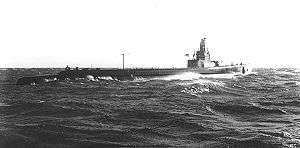USS Golet
 USS Golet (SS-361) | |
| History | |
|---|---|
| Builder: | Manitowoc Shipbuilding Company, Manitowoc, Wisconsin[1] |
| Laid down: | 27 January 1943[1] |
| Launched: | 1 August 1943[1] |
| Commissioned: | 30 November 1943[1] |
| Fate: | Sunk by Japanese vessels northwest of Honshū, 14 June 1944. All 82 crew lost[2] |
| General characteristics | |
| Class and type: | Gato-class diesel-electric submarine[3] |
| Displacement: | |
| Length: | 311 ft 9 in (95.02 m)[2] |
| Beam: | 27 ft 3 in (8.31 m)[2] |
| Draft: | 17 ft 0 in (5.18 m) maximum[2] |
| Propulsion: |
|
| Speed: | |
| Range: | 11,000 nautical miles (13,000 mi; 20,000 km) surfaced at 10 knots (12 mph; 19 km/h)[8] |
| Endurance: |
|
| Test depth: | 300 ft (90 m)[8] |
| Complement: | |
| Armament: |
|
USS Golet (SS-361), a Gato-class submarine, was the only ship of the United States Navy to be named for the golet, a California trout. Her keel was laid down by the Manitowoc Shipbuilding Company of Manitowoc, Wisconsin. She was launched on 1 August 1943 sponsored by Mrs. Wiley, wife of United States Senator Alexander Wiley of Wisconsin, and commissioned on 30 November 1943 with Lieutenant Commander James M. Clement in command.
Golet departed Manitowoc 19 December 1943 via the Mississippi River for New Orleans, Louisiana, arriving 28 December. After shakedown training at Panama and final battle practice in Hawaiian waters, she departed Pearl Harbor on 18 March 1944 for her maiden war patrol off the Kurile Islands chain, Southern Hokkaidō and Eastern Honshū, Japan. Severe combinations of fog, rain, and ice were encountered and only one ship worth a torpedo came into view. This enemy proved too fast for Golet to close to torpedo range; she returned to Midway Island on 3 May 1944.
Lieutenant James S. Clark took command of Golet, departed Midway Island on 28 May 1944 to patrol off northern Honshū, Japan, and was never heard from again.
Golet had been scheduled to depart her area on 5 July and was expected at Midway Island about 12 July or 13 July. She failed to acknowledge a message sent her on 9 July and was presumed lost 26 July 1944.
Japanese antisubmarine records available after the war revealed that Golet was the probable victim of a Japanese antisubmarine attack made 14 June 1944. These records mention that the attack brought up cork, rafts, and other debris and a heavy pool of oil, all evidence of the sinking of a submarine. See also List of U.S. Navy losses in World War II.
See also
References
- 1 2 3 4 Friedman, Norman (1995). U.S. Submarines Through 1945: An Illustrated Design History. Annapolis, Maryland: United States Naval Institute. pp. 285–304. ISBN 1-55750-263-3.
- 1 2 3 4 5 6 Bauer, K. Jack; Roberts, Stephen S. (1991). Register of Ships of the U.S. Navy, 1775-1990: Major Combatants. Westport, Connecticut: Greenwood Press. pp. 271–273. ISBN 0-313-26202-0.
- ↑ Lenton, H. T. American Submarines (Doubleday, 1973), p.78.
- 1 2 3 4 5 Bauer, K. Jack; Roberts, Stephen S. (1991). Register of Ships of the U.S. Navy, 1775–1990: Major Combatants. Westport, Connecticut: Greenwood Press. pp. 275–280. ISBN 978-0-313-26202-9.
- ↑ U.S. Submarines Through 1945 p. 261
- ↑ U.S. Submarines Through 1945 pp. 305–311
- 1 2 3 4 Lenton, p.79.
- 1 2 3 4 U.S. Submarines Through 1945 pp. 305-311
This article incorporates text from the public domain Dictionary of American Naval Fighting Ships. The entry can be found here.
External links
Coordinates: 41°4′N 141°31′E / 41.067°N 141.517°E